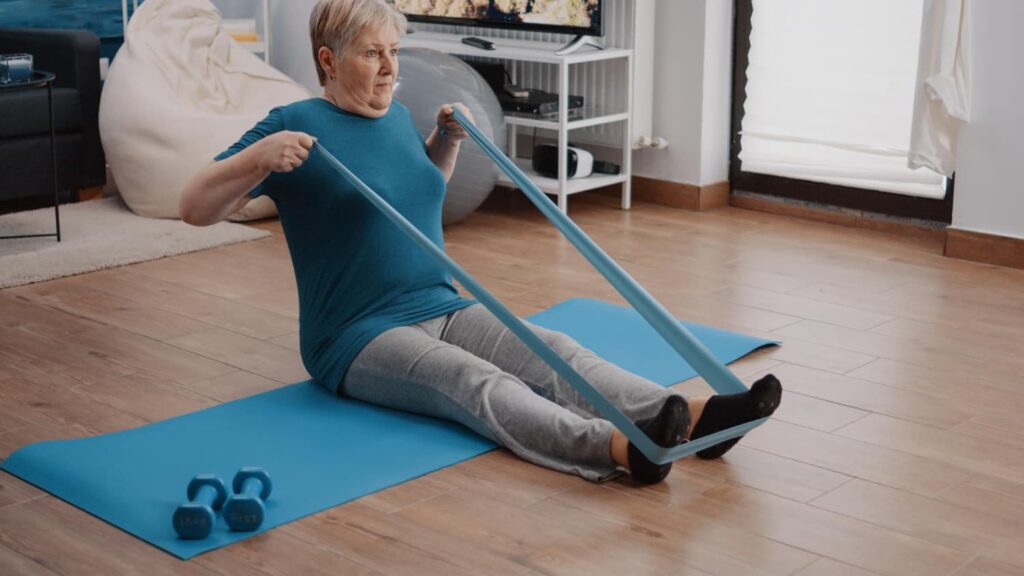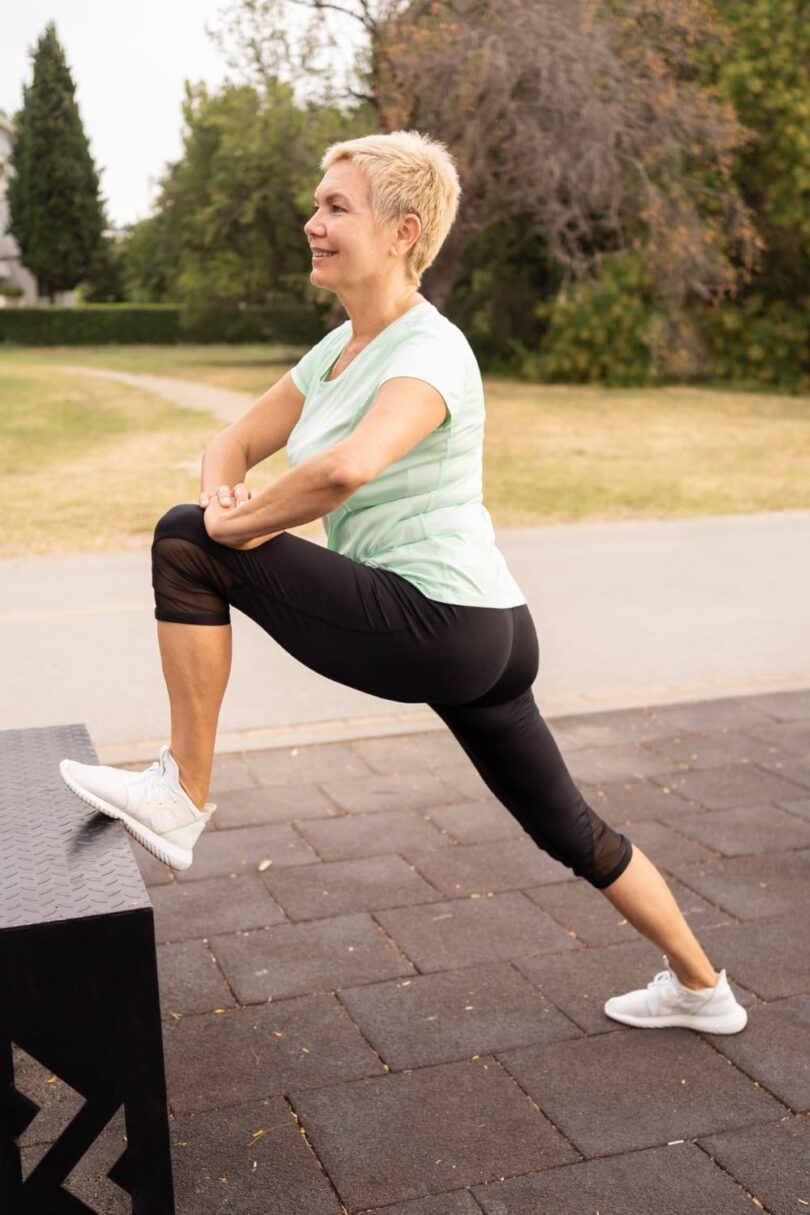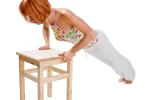Introduction
Chair yoga is an accessible form of exercise that’s making waves, particularly among seniors looking to lose weight and boost overall well-being. This gentle approach to yoga, performed while seated or using a chair for support, offers a practical solution for seniors who may struggle with traditional forms of physical activity. From improving flexibility to enhancing strength and balance, chair yoga is a versatile tool for promoting health. This article dives into everything you need to know about chair yoga for seniors to lose weight, including routines, advanced poses, and tips for integrating this practice into daily life.
Table of Contents
Chair Yoga for Seniors to Lose Weight: Introduction
Chair yoga is not just a buzzword; it’s a real game-changer for seniors aiming to shed some pounds while staying active. This form of yoga adapts traditional poses to be performed while sitting on a chair, making it a perfect fit for those with limited mobility. Not only does it make yoga accessible, but it also brings a host of benefits that can significantly impact a senior’s quality of life.
What is Chair Yoga?
So, what exactly is chair yoga? In simple terms, chair yoga involves modifying classic yoga poses to be performed while seated or using a chair for support. This makes it incredibly accessible to seniors or those who might have difficulty with traditional yoga. The focus remains on improving flexibility, strength, and balance, but in a way that’s safe and comfortable for older adults.
How Chair Yoga Differs from Traditional Yoga
Unlike traditional yoga, where you might find yourself on a mat twisting and turning in various poses, chair yoga keeps things grounded—literally. You remain seated for most of the exercises or use the chair for support during standing poses. This adaptation reduces the risk of falls, which is a significant concern for seniors. Additionally, chair yoga offers the same calming benefits, with breathing exercises and mindfulness practices woven throughout.
Benefits of Chair Yoga for Seniors
The benefits of chair yoga are as wide-ranging as they are profound. For seniors, in particular, these benefits can lead to a more active, fulfilling life.
Improved Flexibility
First and foremost, chair yoga can significantly improve flexibility. Seniors often face stiffness in their joints, making everyday tasks challenging. Regular practice of chair yoga helps to stretch and lengthen muscles, which, in turn, makes it easier to move around and perform daily activities without discomfort.
Enhanced Strength
But wait, there’s more! Chair yoga isn’t just about stretching. It’s also a fantastic way to build strength. Many of the poses target the muscles, helping to maintain and even build muscle mass, which is crucial as we age. Strong muscles support the joints, reduce the risk of injury, and enhance overall mobility.
Better Balance
Speaking of mobility, balance is another area where chair yoga shines. As we age, our balance tends to decline, increasing the risk of falls. Chair yoga incorporates balancing poses that, over time, can improve stability. This means seniors can move with more confidence and less fear of losing their footing.
Mental Well-being
It’s not all about the physical, though. Chair yoga also plays a significant role in mental well-being. Through focused breathing exercises and mindful movement, seniors can reduce stress and anxiety. This mental clarity and calmness can make a huge difference in day-to-day life, promoting a sense of peace and relaxation.
Weight Loss
And let’s not forget the main goal—weight loss. Chair yoga may seem gentle, but don’t let that fool you. It’s a great way to burn calories and shed unwanted pounds, especially when combined with a healthy diet. Consistent movement and muscle engagement during chair yoga help to boost metabolism and promote weight loss in a safe and controlled manner.
Preparing for Chair Yoga
Getting ready for chair yoga is simple, but a little preparation can go a long way in making your practice safe and enjoyable. Whether you’re a seasoned yogi or a complete beginner, setting up your space and gathering the right gear is crucial. Here’s how you can get started on the right foot.
Choosing the Right Chair
The chair you use plays a big role in your comfort and stability during yoga practice. You’ll want to pick a sturdy chair with a straight back and no wheels. A chair that doesn’t have arms is ideal since it allows for a greater range of movement. Place the chair on a flat, non-slip surface to prevent any accidental slips or tipping. Remember, the chair should support you, not wobble beneath you.
Wearing Comfortable Clothing
What you wear during chair yoga matters more than you might think. Opt for loose, comfortable clothing that allows you to move freely. Tight or restrictive clothing can limit your range of motion, making it harder to get the most out of each pose. You don’t need anything fancy—just something that lets you stretch and bend without feeling restricted.
Creating a Safe Environment
Before you begin, take a moment to create a safe and calming environment. Clear away any clutter around your chair, especially items that could trip you up or get in the way. If possible, find a quiet spot where you won’t be interrupted. This helps you focus on your practice and makes the experience more relaxing.
Listening to Your Body
One of the most important aspects of chair yoga—or any yoga, for that matter—is listening to your body. It’s easy to get caught up in the idea of pushing yourself, but yoga is about moving within your limits. Pay attention to how each movement feels. If something doesn’t feel right or causes pain, stop and modify the pose. The goal is to make your practice beneficial, not to strain yourself.
Gathering Your Tools
Although chair yoga doesn’t require a lot of equipment, a few tools can help enhance your practice. A yoga mat placed under the chair can prevent slipping, especially if you’ll be doing any standing poses. Additionally, having a strap or a belt nearby can assist with certain stretches, especially if your flexibility is limited. If you’re dealing with balance issues, placing the chair against a wall can offer added stability.
Hydration and Nutrition
While chair yoga isn’t as intense as some other forms of exercise, staying hydrated is still key. Have a bottle of water nearby to sip on before and after your session. It’s also a good idea to eat a light snack beforehand if it’s been a while since your last meal. This keeps your energy levels steady throughout your practice.
Basic Chair Yoga Poses
Starting with basic chair yoga poses is a great way to ease into your practice, especially if you’re new to yoga or dealing with mobility issues. These poses are designed to gently stretch and strengthen your body, making them perfect for seniors who want to stay active and lose weight. Let’s dive into some simple poses that you can incorporate into your daily routine.
Seated Mountain Pose (Tadasana)
The Seated Mountain Pose is a foundational pose in chair yoga. It helps you find your posture, engage your core, and focus on your breath—all essential elements of yoga.
How to do it:
- Sit tall in your chair with your feet flat on the floor, about hip-width apart.
- Rest your hands on your thighs, palms facing down.
- Lengthen your spine by reaching the crown of your head towards the ceiling.
- Engage your core muscles by gently pulling your belly button towards your spine.
- Hold this position for 5-10 breaths, focusing on deep, even breathing.
This pose is simple yet powerful, helping to align your body and calm your mind.
Seated Forward Fold (Paschimottanasana)
The Seated Forward Fold is a gentle stretch that targets the back and hamstrings, which can often become tight with age.
How to do it:
- Sit on the edge of your chair with your feet flat on the floor.
- Inhale and lengthen your spine, sitting up as tall as possible.
- As you exhale, hinge forward at your hips, reaching your hands towards your toes or the floor.
- Allow your head and neck to relax, letting gravity deepen the stretch.
- Hold for 5-10 breaths, feeling the stretch along your back and legs.
This pose is wonderful for relieving tension in the lower back and improving flexibility.
Seated Twist (Ardha Matsyendrasana)
The Seated Twist is excellent for spinal mobility and can aid in digestion by gently massaging the internal organs.
How to do it:
- Sit tall with your feet flat on the floor and knees together.
- Place your right hand on the back of the chair and your left hand on your right knee.
- Inhale to lengthen your spine, then exhale as you twist your torso to the right, looking over your right shoulder.
- Hold the twist for 5-10 breaths, deepening the twist with each exhale.
- Slowly return to the center and repeat on the other side.
Twists are great for keeping the spine flexible and releasing tension in the back.
Related Article: Free Chair Yoga for Seniors to Lose Weight

Chair Yoga Routines for Weight Loss
Chair yoga isn’t just a gentle way to stretch; it can also be an effective tool for weight loss when practiced consistently. By incorporating movement, stretching, and mindfulness, chair yoga can help you burn calories, build strength, and improve overall well-being. Here’s a daily routine designed specifically to support weight loss, followed by a 28-day challenge to keep things fresh and engaging.
Daily Chair Yoga Routine
A daily routine is a powerful way to integrate chair yoga into your life, and it doesn’t have to take long. This simple yet effective routine can be done in the morning to start your day off right or in the evening to unwind. Each pose flows into the next, creating a sequence that helps with calorie burning, muscle toning, and stress reduction.
Warm-Up: Seated Cat-Cow Stretch
Starting with a gentle warm-up is crucial to prepare your body for the routine ahead.
How to do it:
- Sit on the edge of your chair with your feet flat on the floor.
- Place your hands on your knees.
- Inhale as you arch your back, lifting your chest and looking up (Cow Pose).
- Exhale as you round your spine, tucking your chin to your chest (Cat Pose).
- Repeat for 5-10 breaths, moving with your breath.
This stretch helps to loosen up the spine and engage the core muscles, setting the stage for the rest of the routine.
Seated Side Stretch
Side stretches are great for working the obliques and improving flexibility in the spine.
How to do it:
- Sit tall with your feet flat on the floor.
- Raise your right arm overhead, reaching towards the ceiling.
- Lean to the left, stretching your right side.
- Hold for 5-10 breaths, then switch sides.
This pose helps to tone the waistline and can aid in reducing love handles.
Seated Warrior I
Warrior poses are fantastic for building strength, particularly in the legs and core, which are crucial for weight loss.
How to do it:
- Sit on the edge of your chair with your feet flat on the floor.
- Step your right foot back, keeping your left foot forward.
- Raise both arms overhead, reaching towards the ceiling.
- Hold for 5-10 breaths, then switch sides.
Seated Warrior I engages multiple muscle groups, making it a great pose for burning calories.
Seated Marching
Adding a bit of cardio to your chair yoga routine can boost your metabolism and help with weight loss.
How to do it:
- Sit tall with your feet flat on the floor.
- Lift your right knee towards your chest, then lower it and lift your left knee.
- Continue marching in place for 1-2 minutes, keeping your core engaged.
This simple move gets your heart rate up and helps burn extra calories.
28-Day Chair Yoga Challenge
If you’re looking for a structured plan to follow, the 28-day chair yoga challenge is perfect. It’s designed to gradually increase in intensity, helping you build strength, flexibility, and stamina over time.
Week 1: Building the Foundation
Focus: Basic poses and gentle stretches to get your body accustomed to chair yoga.
Routine:
- Seated Mountain Pose
- Seated Forward Fold
- Seated Twist
- Seated Cat-Cow Stretch
Week 2: Increasing Intensity
Focus: Introducing strength and balance poses to start toning muscles.
Routine:
- Seated Side Stretch
- Seated Warrior I
- Seated Warrior II
- Seated Marching
Week 3: Combining Poses
Focus: Creating flow sequences and adding dynamic movements to increase calorie burn.
Routine:
- Seated Flow Sequence (Cat-Cow, Forward Fold, Twist)
- Seated Sun Salutation (adapted)
- Seated Chair Pose
- Seated Knee Lifts
Week 4: Advanced Techniques
Focus: Introducing more challenging poses and longer holds to push your practice further.
Routine:
- Seated Eagle Pose
- Seated Pigeon Pose
- Seated Warrior III
- Seated Boat Pose
Advanced Chair Yoga Poses
Once you’ve got the basics down, you might be ready to take your chair yoga practice to the next level. Advanced poses offer more of a challenge, helping to build strength, flexibility, and balance. While these poses are more demanding, they’re still accessible to most seniors, provided you listen to your body and move at your own pace. Let’s dive into some advanced chair yoga poses that can help you push your limits while staying safe.
Seated Eagle Pose (Garudasana)
The Seated Eagle Pose is a fantastic way to work on both balance and flexibility, especially in the shoulders and hips. It’s also great for improving focus and concentration.
How to do it:
- Sit tall in your chair with your feet flat on the floor.
- Cross your right thigh over your left thigh. If possible, wrap your right foot around your left calf.
- Extend your arms forward, then cross your right arm over your left at the elbows.
- Bend your elbows and try to bring your palms together or as close as you can.
- Hold for 5-10 breaths, then switch sides.
This pose requires concentration and balance, making it a great challenge for those looking to deepen their practice.
Seated Pigeon Pose (Eka Pada Rajakapotasana)
The Seated Pigeon Pose targets the hips, which can often become tight, especially if you spend a lot of time sitting. This pose is excellent for stretching the hips and relieving tension in the lower back.
How to do it:
- Sit on the edge of your chair with your feet flat on the floor.
- Place your right ankle on your left thigh, just above the knee.
- Flex your right foot to protect your knee and keep your back straight.
- Lean forward slightly, feeling a stretch in your right hip.
- Hold for 5-10 breaths, then switch sides.
This pose is particularly effective for opening the hips and can help alleviate discomfort from tightness or tension.
Seated Warrior III (Virabhadrasana III)
Seated Warrior III is a powerful pose that works on balance, core strength, and leg muscles. It’s a great way to challenge yourself while still maintaining the support of the chair.
How to do it:
- Sit tall with your feet flat on the floor.
- Extend your right leg straight out in front of you, keeping it parallel to the floor.
- Lean forward slightly, reaching your arms forward or alongside your body.
- Engage your core and hold for 5-10 breaths, then switch sides.
This pose challenges your balance and strengthens your core, making it an excellent addition to your chair yoga routine.
Seated Boat Pose (Navasana)
The Seated Boat Pose is a great way to build core strength, which is crucial for overall stability and balance. It also engages the legs, making it a full-body exercise.
How to do it:
- Sit on the edge of your chair with your feet flat on the floor.
- Lift both legs, keeping them straight until they are parallel to the floor.
- Extend your arms forward, parallel to the floor.
- Engage your core and hold for 5-10 breaths.
This pose is challenging but incredibly rewarding, helping to strengthen the core and improve balance.
Tips for Practicing Advanced Poses
While advanced chair yoga poses are more demanding, they can be incredibly beneficial if practiced correctly. Here are a few tips to keep in mind:
- Warm-Up First: Always start with a warm-up to get your muscles ready.
- Breathe Deeply: Focus on your breath to maintain balance and stay calm.
- Take It Slow: Don’t rush into the poses. Move slowly to avoid injury.
- Modify If Needed: If a pose feels too challenging, modify it to suit your body’s needs.
Related Article: Yoga Poses for Men Over 50: Best Exercises for Flexibility and Strength
Integrating Chair Yoga into Daily Life
Making chair yoga a regular part of your daily routine can bring lasting benefits to both your physical and mental well-being. The beauty of chair yoga lies in its flexibility—it can be done almost anywhere, whether you’re at home, at work, or even on the go. Here are some practical ways to weave chair yoga into your everyday life, helping you stay active and healthy with minimal effort.
Combining Chair Yoga with Other Activities
One of the easiest ways to integrate chair yoga into your daily life is by combining it with activities you already do. This approach allows you to add movement and mindfulness to your routine without needing to carve out extra time in your day.
During TV Time: Instead of sitting passively while watching your favorite shows, use commercial breaks or slow scenes as opportunities to practice a few chair yoga poses. Simple stretches like the Seated Forward Fold or Seated Twist can be done without taking your eyes off the screen, making this a seamless addition to your relaxation time.
At Work: Sitting at a desk for long periods can lead to stiffness and discomfort. Taking short chair yoga breaks throughout your workday can help relieve tension, boost energy levels, and improve focus. Poses like the Seated Cat-Cow Stretch or Seated Side Stretch can be done right at your desk, keeping you refreshed and ready to tackle your tasks.
Morning Routine: Starting your day with chair yoga can set a positive tone, helping you wake up your body and mind. A quick routine of Seated Mountain Pose, Seated Warrior I, and Seated Marching can get your blood flowing and prepare you for the day ahead. Plus, it’s a gentle way to ease into the morning, especially if you’re not a fan of intense exercise first thing.
Chair Yoga for Daily Flexibility
Maintaining flexibility is key to staying mobile and active as you age. Integrating chair yoga poses throughout your day can help keep your muscles and joints supple, reducing stiffness and preventing injury.
Seated Neck Stretch: This simple stretch can be done anytime you feel tension building in your neck and shoulders. Sit tall with your feet flat on the floor, then gently tilt your head to one side, bringing your ear towards your shoulder. Hold for a few breaths, then switch sides. This stretch is perfect for releasing the stress that accumulates during daily activities.
Seated Spinal Stretch: For a deeper stretch in your back, try the Seated Spinal Stretch. Sit tall with your feet flat on the floor, then place your right hand on the back of your chair and your left hand on your right knee. Inhale to lengthen your spine, then exhale as you twist to the right, looking over your shoulder. Hold for a few breaths, then repeat on the other side. This pose helps maintain spinal mobility, which is crucial for overall flexibility.
Combining Chair Yoga with Walking
Walking is an excellent complement to chair yoga. It promotes cardiovascular health, supports weight loss, and can be easily integrated into your routine. Combining walking with chair yoga offers a balanced approach to staying fit and active.
Warm-Up with a Walk: Start your day or exercise routine with a 5-10 minute walk. This warms up your muscles and prepares your body for chair yoga.
Follow with a Chair Yoga Session: After your walk, spend 10-15 minutes practicing chair yoga. The combination of walking and yoga helps improve circulation, flexibility, and strength.
Cool Down: End with a gentle 5-minute walk to cool down your muscles and bring your heart rate back to normal. This balanced approach helps to maximize the benefits of both activities.
Success Stories
Hearing about others’ success with chair yoga can be a great motivator. Here are a few stories from seniors who have integrated chair yoga into their lives with positive results:
Helen, 72: “I started doing chair yoga during TV time, and it’s made a huge difference in my flexibility. I’ve also lost a few pounds, which is a nice bonus!”
Tom, 68: “Adding chair yoga breaks into my workday has really helped with my back pain. I feel more energized and focused after just a few stretches.”
Mary, 75: “I love starting my day with chair yoga. It’s gentle enough that I can do it every morning, and it sets a calm, positive tone for the day.”
Tips for Maintaining a Chair Yoga Routine
Staying consistent with chair yoga is key to reaping its long-term benefits. Here are some tips to help you stick with your practice:
- Set a Schedule: Choose a specific time each day for your chair yoga practice. Whether it’s first thing in the morning, during lunch, or before bed, making it a routine helps you stay consistent.
- Make It Enjoyable: Find a quiet, comfortable space and maybe play some soothing music to create a pleasant atmosphere for your practice.
- Track Your Progress: Keep a journal of your practice. Note any improvements in flexibility, strength, and weight loss, which can be motivating as you see your progress over time.
Frequently Asked Questions (FAQs)
Is Chair Yoga Effective for Weight Loss?
Yes, chair yoga can be effective for weight loss, especially when combined with a balanced diet and regular practice. While it might seem gentle, chair yoga helps to burn calories, build muscle, and boost metabolism. The key is consistency—practicing regularly can lead to gradual and sustainable weight loss.
How Often Should Seniors Practice Chair Yoga?
For the best results, it’s recommended to practice chair yoga at least three to four times a week. However, even doing a little bit every day can make a big difference in your flexibility, strength, and overall well-being. The beauty of chair yoga is that it can fit into your schedule, whether you have 10 minutes or an hour.
Can Chair Yoga Improve Flexibility?
Absolutely! Chair yoga is a great way to improve flexibility, especially if you’re dealing with stiffness or limited mobility. The gentle stretches and movements in chair yoga help to lengthen muscles and increase the range of motion over time. With regular practice, you’ll likely notice that everyday activities become easier and more comfortable.
Is Chair Yoga Safe for People with Arthritis?
Chair yoga is particularly beneficial for people with arthritis. The gentle movements can help reduce joint pain and stiffness, improve circulation, and increase flexibility without putting too much strain on the joints. However, it’s important to listen to your body and avoid any movements that cause discomfort. If you have severe arthritis, it’s a good idea to consult with your doctor before starting chair yoga.
Do I Need Special Equipment to Do Chair Yoga?
No special equipment is needed to start chair yoga. All you need is a sturdy chair with no wheels and comfortable clothing that allows for easy movement. If you want to deepen your practice, you can use a yoga mat for extra stability or a yoga strap for additional support during stretches. However, these items are optional.
Can Chair Yoga Help with Balance Issues?
Yes, chair yoga can improve balance, which is especially important as we age. Many chair yoga poses focus on strengthening the core and leg muscles, which are key to maintaining balance. Over time, practicing chair yoga can help reduce the risk of falls and increase confidence in daily movements.
Is Chair Yoga Suitable for Beginners?
Chair yoga is an excellent choice for beginners, particularly seniors or those with limited mobility. The poses are adapted to be performed while seated, making them accessible and easy to follow. Whether you’re new to yoga or looking for a gentler practice, chair yoga offers a great starting point.
Conclusion
Chair yoga is more than just a gentle exercise; it’s a powerful tool for improving health and well-being, especially for seniors. From increasing flexibility and strength to aiding in weight loss and reducing stress, chair yoga offers a host of benefits that can significantly enhance your quality of life.
The best part about chair yoga is its accessibility. It doesn’t require any fancy equipment or a lot of space—just a sturdy chair and a willingness to move. Whether you’re a beginner or have been practicing yoga for years, chair yoga can be adapted to meet your needs, making it an excellent choice for anyone looking to stay active and healthy.
By integrating chair yoga into your daily routine, you can enjoy these benefits without having to set aside large chunks of time. Whether it’s during your morning routine, while watching TV, or even at your desk, there are countless ways to make chair yoga a regular part of your life.
As you’ve seen from the success stories of others, the impact of chair yoga can be profound. It’s a simple, effective, and enjoyable way to improve your physical and mental health, helping you feel more vibrant and engaged in your daily life.
So why not give chair yoga a try? Start with a few basic poses, build your routine, and soon you’ll discover the many ways this practice can positively affect your life. Remember, the journey to better health doesn’t have to be complicated or strenuous—it can be as simple as sitting down and stretching out.
Related Article: Chair Yoga for Seniors to Lose Weight







